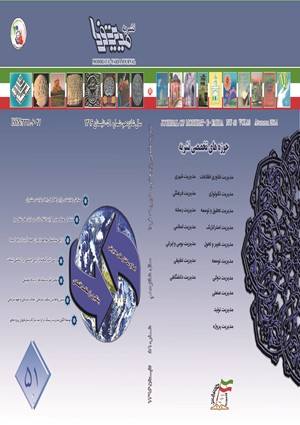تأثیر چابکی تولید بر بهبود بهرهوری سازمانی
محورهای موضوعی : مدیریت صنعتی
غلامرضا هاشم زاده
1
![]() ,
محمدرضا بهرامی
2
,
محمدرضا بهرامی
2
1 - تهران
2 - دانشگاه آزاد اسلامی واحد تهران جنوب
کلید واژه: تولید چابک بهرهوری سازمانی مشتری محوری مدیریت هزینه,
چکیده مقاله :
امروزه افزايش بي ثباتي و آشفتگي ها محيط هاي سازماني باعث شده که سازمان ها برای پاسخگويي به نیازهای مشتریان در شرایط غیرقابلپیشبینی، به سطحی از چابکی در تولید دست یابند؛ زیرا آن عامل اصلی موفقیت و بقای بنگاهها تلقی می شود. درصورتیکه شرکت های تولیدی توجه چندانی به این مسائل ندارند. هدف اصلی این پژوهش بررسی تأثیر تولید چابک برافزایش بهره وری سازمان می باشد. بدین منظور تعدادی از کارکنان شرکت سیم و کابل مغان بهعنوان مورد مطالعه انتخاب شدند. پژوهش مذکور از نوع کاربردی با رویکرد پیمایشی میباشد که بهصورت مقطعی بر روی نمونه 134 نفری از مديران ،كارشناسان و کارکنان مطلع از موضوع موردمطالعه از شرکت مذکور که بهصورت تصادفی ساده انتخابشده بودند، انجام پذیرفت. پس از شناسایی شاخص های مربوط به بهرهوری و تولید چابک پرسشنامه طراحی گردید که روایی آن توسط اساتید و جمعی از خبرگان کارخانه مورد تأیید قرار گرفت و پایایی آن نیز با روش آلفای کرونباخ محاسبه گردید که 0.90 به دست آمد. تجزیهوتحلیل دادهها نیز با استفاده از آمار توصیفی و استنباطی بهمنظور بررسی رابطهی بین متغیرها به کمک نرمافزارهای آماری SPSS20 و SmartPLS2 صورت گرفت. نتایج بهدستآمده از پژوهش نشان داد که بالا بودن سطح تولید چابک تأثیر بسزایی برافزایش بهره وری در شرکت مذکور دارد.
Today, the increase in instability and turbulence in organizational environments has made organizations achieve certain levels of agile manufacturing to meet the needs of their customers in unpredictable conditions, as agile manufacturing is considered the major contributor to the success and survival of firms. However, many manufacturing firms do not pay much attention to such issues. This paper was mainly aimed at investigating the role of agile manufacturing in improving organizational productivity. To this end, a number of employees at Moghan Wire & Cable Company were selected as the study sample. The research was an applied cross-sectional survey. Simple random sampling was used to select 134 managers, specialists and employees familiar with agile manufacturing at Moghan Wire & Cable Company. After identifying productivity and agile manufacturing indicators, a questionnaire was designed. The questionnaire’s validity was confirmed by professors and a group of experts at Moghan Wire & Cable Company. Cronbach’s alpha was used to evaluate the questionnaire’s reliability. The questionnaire’s Cronbach’s alpha was 0.90. Descriptive and inferential statistics were applied to analyze the collected data and find the relationships between the variables. The analyses were performed using SPSS 20 and SmartPLS 2. The results showed that high levels of agile manufacturing had a significant influence on productivity at Moghan Wire & Cable Company.
1. آذربايجاني، کریم. ١٣۶٨، اندازهگیری و تجزیهوتحلیل بهرهوری صنايع کشور؛ اصفهان، سازمان برنامهوبودجه استان اصفهان.
2. العبیدی, م ج. 1392 ، مطالعه نقش کیفی نگهداری و تعمیرات بر چابک سازی فرآیند نگهداری و تعمیرات ( مطالعه موردی : کارخانه فولاد آلیاژی ایران )
3. خوشسیما, غ. ( 1382 ). مقدمهای بر چابکی در سازمان¬ها. مدیریت, تدبیر شماره 134. 55-58
4. سکاران, ا. (1384). روشهای تحقيق در مديريت (نسخه چاپ سوم). (ت. م. شيرازي, مترجم) تهران: موسسه عالي آموزش و پژوهش مديريت و برنامهريزي.
5. سرمد، ز. بازرگان، ع. حجازي، ا. 1380. روشهای تحقيق در علوم رفتاري (نسخه چاپ پنجم). تهران: انتشارات آگاه.
6. شهائی، ب. و رجب زاده، ع. 1384، بررسی ابعاد ارزیابی چابکی سازمانی در سازمانهای دولتی با رویکرد فناوري اطلاعات، دومین کنفرانس بینالمللی مدیریت فناوري اطلاعات و ارتباطات، اسفندماه.
7. نیک پور, ا و برکم, ی. ( 1391 ). چابکی سازمانی و مدل دستیابی به یک سازمان چابک. اقتصاد, راهبرد توسعه/یاس شماره 30 ( علمی-ترویجی ). 151-171
8. Arteta ,B.M. & Giachetti, R.E.,(2004). A Measure of Agility as the complexity of enterprise system, Robotics and computer integarted manufacturing,24: 495-503
9. Fornell, C., and Larcker, D. F. ((1981. “Evaluating Structural Equation Models with Unobservable Variables and Measurement Error,” Journal of Marketing Research. 18(1),: 39-50.
10. Khalili-Damghani, Tavana. (2013). A new fuzzy network data envelopment analysis model for measuring the performance of agility in supply chains. Int J Manuf Techno,1: 291-318
11. Nunnally, J.C. and Bernstein, I.H., (1994). Psychometric theory. New York, NY: McGraw-Hill.
12. Parmenter, D ,((2009. Key Performance Indicators: Developing, Implementing, and Using Winning KPIs, John Wiley and Sons.
13. Tenenhaus, M., Vinzi, V.E., Chantelinc, Y.M & Lauro, c. (2005),” PLS Patch Modeling”, Computational Statistics & Data Analysis, 48 : 159- 205.
14. Wetzels, M., Odekerken-Schröder, G., & Van Oppen, C. (2009). “Using PLS path modeling for assessing hierarchical construct models: guidelines and empirical illustration”. MIS quarterly.
15. Wireman, T 2005, Developing performance indicators for managing maintenance, Industrial Press Inc.
16. Vazquez-Bustelo, D., Avella, L. & Fernandez, E. (2007), Agility drivers, enablers and outcomes: Empirical test of an integrated agile manufacturing model, International Journal of Operations & Production Management, :(27)12 1303-1332


